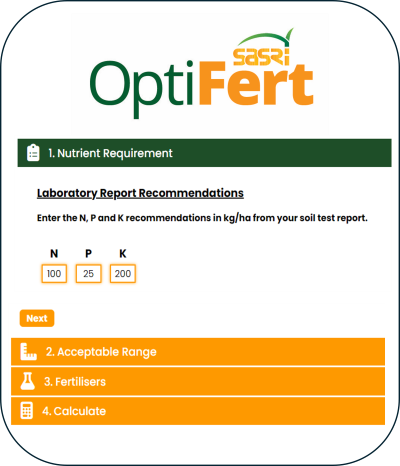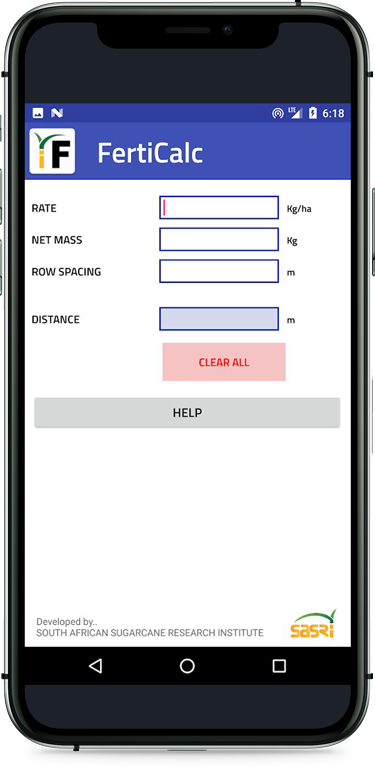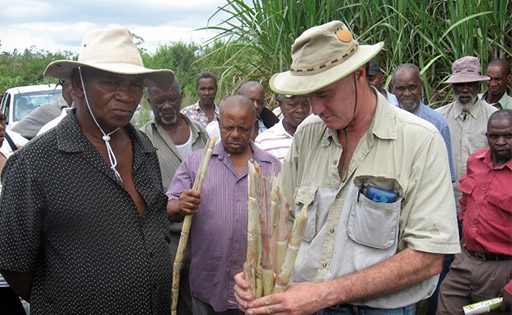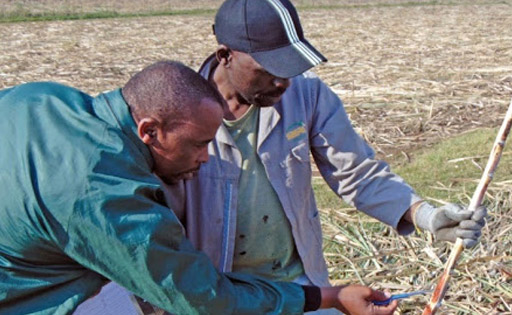Crop Nutrition
Improving Nutrition Efficiency
Fertiliser application is one of the more expensive aspects of establishing and maintaining a sugarcane crop. It is therefore in a grower’s best interest to manage this investment through improved nutrient use efficiency. This can prove to be a complex subject as there are numerous interacting factors affecting how effectively the crop uses the nutrients.
All our advice and information on Crop Nutrition can be found in the various publications, videos and smartphone apps described below.
INFORMATION SHEETS
BOOKS
Understanding and managing soils in the SA sugar industry
Sugarcane production imposes unique stresses on the soil. Monocropping and the removal of large amounts of crop material from the land at harvest, often after burning away crop residues, impact on soil health in various ways. Fortunately, there are several practices that farmers can implement to optimise both soil health and productivity.
This book has been written to serve as a reference guide for students and farmers. It starts by providing a basic understanding of the physical, chemical and biological properties of soils, and then goes on to describe some of the important practices which serve to conserve soil health and thereby promote sustainable agriculture.
Identification and management of the soils of the SA sugar industry
Knowing the soils that occur on a sugarcane farm and understanding how and why they differ will assist growers in deciding how to manage the crop more effectively under different soil bioclimatic conditions and help to increase farm productivity and profitability in harmony with environmental issues. Cane grows well on good soils with relatively little management, but greater knowledge is required of the many poor soils in the sugar industry if they are to be conserved and managed in the best way possible.
This book is designed to provide a practical guide on how to identify, name and manage the more common soils that occur in the industry. Several new soil forms have been identified and where appropriate soil families have been introduced into the system in line withthe publication, Soil Classification – A Taxonomic System for South Africa (published by the Institute for Soil, Climate and Water (formerly Soils and Irrigation Research Institute), 1991).
Green manuring
Green manuring involves the use of selected crops to improve soil health. In the sugar industry, this practice is particularly important to break the sugarcane monoculture and improve overall soil health. There are also benefits from a decrease in diseases and pests that are hosted within the soil from one cane crop to the next.
ILLUSTRATIVE GUIDES
Understanding the FAS Leaf Analysis Report
The SASRI Fertiliser Advisory Service (FAS) conducts routine leaf analysis of sugarcane samples with guidance given on whether the test values are within a predetermined sufficiency range. This guide highlights key features when reading and interpreting this report.
Understanding the FAS Salinity and Sodicity Analysis Report
Soil salinity and sodicity are crop limiting conditions associated with the excess build-up of free salts (salinity) or excess sodium (sodicity). The FAS Agricultural Laboratory at SASRI undertakes routine soil salinity and sodicity analysis to identify the extent of the salinity or sodicity problem, while providing gypsum recommendations in the case of sodicity problems. This guide provides assistance on interpreting the salinity and sodicity report.
Understanding the FAS Top and Subsoil Fertility Analysis Report
The top and subsoil fertility reports produced by the FAS Agricultural Laboratory contain a considerable amount of information. For those not familiar with these reports, this can be overwhelming and confusing. This guide aims to highlight pertinent aspects in the reports and provides guidance on how to use the information to improve nutrient management and soil health.
Understanding the FAS Water Quality Analysis Report
Irrigation water quality must be monitored to ensure suitability of the water for irrigation for different soil properties. Excess salt can lead to serious soil and crop health problems and is costly to remedy. The FAS Agricultural Laboratory undertakes routine irrigation water quality analysis focusing on determination of excess salt and the suitability of the water source for irrigation. In addition, some growers may use this water for agrochemical mixing. Using good quality water is important to optimise the efficacy of chemicals. This booklet provides guidance on interpreting the water quality report for irrigation purposes and interpreting the results for use in agrochemical mixing applications.
Fertilisers
A basic guide describing what fertilisers are, the need for fertilisers, types of fertilisers, procedure for submitting soil samples, application procedures and other general fertiliser tips.
Fertilisers (isiZulu)
A basic guide describing what fertilisers are, the need for fertilisers, types of fertilisers, procedure for submitting soil samples, application procedures and other general fertiliser tips.
How to use a Beta Sampler
Step-by-step guide for using a Beta Sampler to take soil samples.
Micronutrient deficiency symptoms in sugarcane
Leaf deficiency symptoms for Iron, Copper, Zinc, Maganese, Boron and Molybdenum
Nutrient deficiency symptoms in sugarcane
Describes deficiency symptoms for Nitrogen, Phosphorus, Potassium, Sulphur, Calcium and Magnesium.
Soil testing
Field procedures for taking samples for soil testing
VIDEOS
Top dressing (isiZulu)
The importance of fertiliser application (IsiZulu)
Fertiliser Advisory Service
Leaf Sampling
Soil Sampling
Leaf Sampling (isiZulu)
Soil Sampling (isiZulu)
Tin and string fertiliser application
Knapsack fertiliser application
SMARTPHONE & DESKTOP APPS
OptiFert
Optimum fertiliser combinations in a few clicks!
OptiFert is a user-friendly internet-based application that enables growers to quickly determine the most cost-effective and suitable fertiliser options for specific NPK requirements. Given that fertilisers represent one of the largest expenses in sugarcane farming, optimising their use is crucial.
While calculating fertiliser types and rates is typically straightforward, it becomes complex when comparing multiple products and prices across various fields with different nutrient needs. OptiFert simplifies this process, providing answers within a few clicks.
Users input their nutrient requirements (as determined by a laboratory), select preferred or available fertilisers, and input current fertiliser costs. OptiFert then displays recommended fertilisers, required volumes, expected nutrient surpluses or deficits, and the total cost of the combinations. Selections can be easily modified to compare different choices.
Even when external nutrition service providers are used, OptiFert allows growers to conduct their own assessments and cross-check the advice received, thereby ensuring optimal decision-making.
Try OptiFert

FertiCalc
Helping you calculate fertiliser distances at the touch of a button!
A ‘Fertiliser distance’ is the distance that a given amount of fertiliser must cover in order to achieve the recommended rate per hectare. Whether you use the tin-and-string method, or wish to calibrate the flow-rate of a knapsack fertiliser applicator or some other application equipment, FertiCalc will simplify the process.
The app is available for free download from the Google Play and iPhone App stores.

SERVICES
FAS Agricultural Laboratory
Analytical packages offered for soil, leaf, fertiliser, compost and irrigation water. Recommendations provided for sugarcane and selected crops for local and SADC clients.
Extension and Biosecurity Service
SASRI Extension Specialists located throughout the South African sugar industry are available to offer advice and support on crop nutrition and all other aspects of sugarcane farming.
Research in Crop Nutrition focuses on the development of knowledge, technologies, and resources to further enhance the accuracy of fertiliser recommendations to the grower community. Visit CROP PERFORMANCE & MANAGEMENT for more info.
Subscribe to our News Alerts to receive our latest information.






